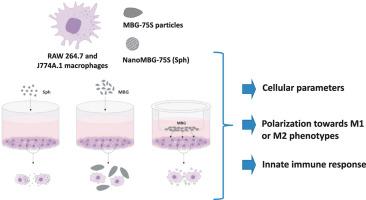Colloids and Surfaces B: Biointerfaces ( IF 5.4 ) Pub Date : 2021-09-12 , DOI: 10.1016/j.colsurfb.2021.112110 M J Feito 1 , L Casarrubios 1 , M Oñaderra 1 , M Gómez-Duro 1 , P Arribas 1 , A Polo-Montalvo 1 , M Vallet-Regí 2 , D Arcos 2 , M T Portolés 3

|
Mesoporous bioactive glasses (MBGs) are bioceramics designed to induce bone tissue regeneration and very useful materials with the ability to act as drug delivery systems. MBGs can be implanted in contact with bone tissue in different ways, as particulate material, in 3D scaffolds or as nanospheres. In this work, we assessed the effects of particles of mesoporous bioactive glass MBG-75S and mesoporous nanospheres NanoMBG-75S on RAW 264.7 and J774A.1 macrophages, which present different sensitivity and are considered as ideal models for the study of innate immune response. After evaluating several cellular parameters (morphology, size, complexity, proliferation, cell cycle and intracellular content of reactive oxygen species), the action of MBG-75S particles and NanoMBG-75S on the polarization of these macrophages towards the pro-inflammatory (M1) or reparative (M2) phenotype was determined by the expression of specific M1 (CD80) and M2 (CD206, CD163) markers. We previously measured the adsorption of albumin and fibrinogen on MBG-75S particles and the production of pro-inflammatory cytokines as TNF-α and IL-6 by macrophages in response to these particles. This comparative study demonstrates that particles of mesoporous bioactive glass MBG-75S and mesoporous nanospheres NanoMBG-75S allow the appropriated development and function of RAW 264.7 and J774A.1 macrophages and do not induce polarization towards the M1 pro-inflammatory phenotype. Therefore, considering that these mesoporous biomaterials offer the possibility of loading drugs into their pores, the results obtained indicate their high potential for use as drug-delivery systems in bone repair and osteoporosis treatments without triggering an adverse inflammatory response.
中文翻译:

RAW 264.7 和 J774A.1 巨噬细胞对介孔生物活性玻璃颗粒和纳米颗粒的反应:一项比较研究
介孔生物活性玻璃 (MBG) 是一种旨在诱导骨组织再生的生物陶瓷,是一种非常有用的材料,具有作为药物输送系统的能力。MBG 可以以不同方式植入与骨组织接触,如颗粒材料、3D 支架或纳米球。在这项工作中,我们评估了介孔生物活性玻璃 MBG-75S 和介孔纳米球 NanoMBG-75S 对 RAW 264.7 和 J774A.1 巨噬细胞的影响,它们表现出不同的敏感性,被认为是研究先天免疫反应的理想模型。在评估了几个细胞参数(形态、大小、复杂性、增殖、细胞周期和细胞内活性氧含量)后,MBG-75S 颗粒和 NanoMBG-75S 对这些巨噬细胞向促炎 (M1) 或修复 (M2) 表型极化的作用由特定 M1 (CD80) 和 M2 (CD206, CD163) 标记的表达决定. 我们之前测量了白蛋白和纤维蛋白原在 MBG-75S 颗粒上的吸附以及巨噬细胞响应这些颗粒而产生的促炎细胞因子如 TNF-α 和 IL-6。这项比较研究表明,介孔生物活性玻璃 MBG-75S 和介孔纳米球 NanoMBG-75S 的颗粒允许 RAW 264.7 和 J774A.1 巨噬细胞的适当发育和功能,并且不会诱导对 M1 促炎表型的极化。因此,考虑到这些介孔生物材料提供了将药物加载到其孔隙中的可能性,











































 京公网安备 11010802027423号
京公网安备 11010802027423号